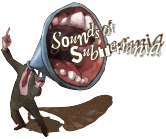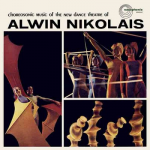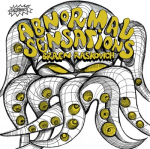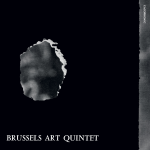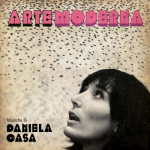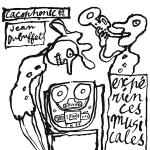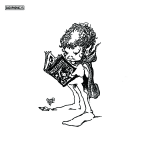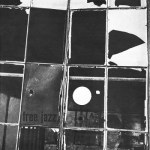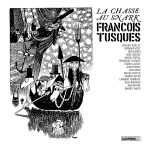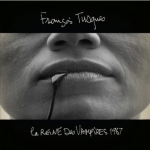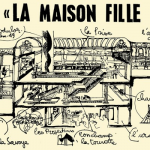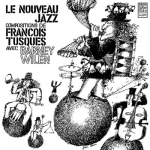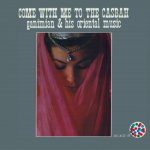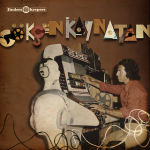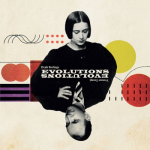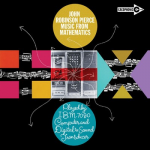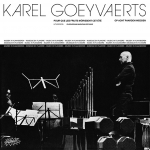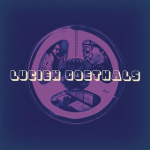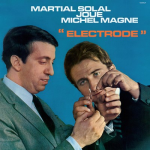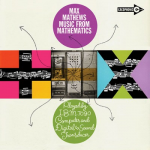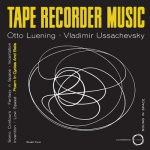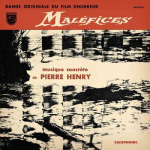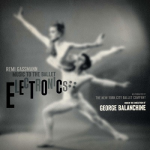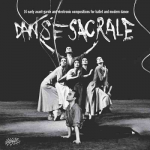Labels
Cacophonic
- 01. Eruptions And Evolvements
02. Lythic
03. Illusional Frieze
04. Shivaree
05. Aeolus
06. Paraphrenalia
07. Lyre
08. Prismatic Forest
09. Fixation
10. Glymistry
11. FetishALWIN NIKOLAIS
Choreosonic Music Of The New Dance Theatre Of Alwin Nikolais
[engl] Choreosonics was the name of the music for the choreography of Alwin Nikolais - a unique theatre exposition that was described in the late 50s as “the new theatre of shape, motion, light and sound.” In 1953 Nikolais attracted people interested in new art to his dance concerts at the Henry Street Playhouse in New York City. In these con- certs dancers became colourful motivating sources for sculptural shapes; moving in changing atmospheres of light and sound their relationship carefully integrated into a new kind of audiovisual abstract theatre art. The sounds created for this were not con- ceived from traditional music points of view but were designed to share and support the total visual dynamics. Such a creation was possible because of Nikolais’ background as a musician as well as choreographer. At sixteen he was playing piano and organ for the then disappear- ing silent films, improvising and coordinating music four to six hours daily to the dra- matic content of the movie. With this profession obsolete, he turned his skill into accom- paniment for dance. Through this his interests led to his study of percussion accompa- niment and exploration of new sounds. These ideas were stimulated by the kind of dance accompaniment introduced by the famous German dancer, Mary Wigman. This, in turn, induced Nikolais to study dance and ultimately to switch his career from musi- cian to dancer and choreographer. Nikolais was soon heralded as one of the leading figures in modern concert dance, he is credited with bringing about revolutionary ideas opening up new vistas for dance and theatre. Nikolais' activities were centered at the Henry Street Playhouse in New York. His work was created there with his assistant Murray Louis; sound engineer David S. Berlin; artist George Constant and members of his Playhouse Dance Company. All of whom had a hand in the final productions. Performances with names like Prism, Cantos and Totem were met with positive critical view for their multidisciplinary achieve- ments. While his collaboration with Harry Partch on The Bewitched established his name alongside another true maverick of American sound design and forward-thinking composition. Some of Nikolais' dancers were also trained as percussionists who improvised on a curious assortment of sound producing instruments and objects while other dancers worked through the choreography. David Berlin, who assembled and constructed the sound recording equipment, would operate from the sound booth from a window over- looking the stage. Nikolais would direct the experiments and improvising. Within any performance there would be numerous tests of the original sound and their possible electronic conditioning, including many playbacks of short phrases tested to the dancers’ motion. When the sound phrase proved satisfactory the next cut was start- ed. Sounds were cut down, enlarged, replaced and then the whole piece would be linked together and given final editing much the same as a filming process. Nikolais generally tried to avoid any identification of the sound sources, thus inviting the ear to perceive the sound itself divorced from its initial derivation. This, however, was by no means a final criterion, the ultimate one being the value of the sound to the theatre idea at hand whatever its source or manner of conditioning was. The objects used to pro- duce these sounds were without limit except for practical material size. Within the col- lection many percussion instruments were used: drums of all kinds, rattles, bells, gongs, cymbals, wooden blocks, etc. Also whistles, tubes, pipes, pieces of wood, alu- minum, steel and tin containers were utilised alongs-ide glasses, elastic bands, coils of wire, etc. The back of an upright piano in addition to a grand piano were also often at hand. The human voice would be used freely, hand clapping, foot stomping and any sound producing device whatsoever that might served a purpose.- Format
- LP
- Release-Datum
- 16.12.2013
- EAN
- EAN 5060099505119
- 01. Sensazioni Abnormi (Part One)
02. Cattura
03. Perquisizione
04. Bisca
05. Indagine Notturna
06. Evasioni Psichiche (Part One)
07. Sensazioni Abnormi (Part Two)
08. Rastrellamento
09. Braccio Della Morte
10. Evasioni Psichiche (Part Two)
11. La mala
12. PremeditazioneBRAEN RASKOVICH
Abnormal Sensations
[engl] Collectively known under their production pop group moniker The Pawnshop, Italian Giallo/Spaghetti legends Alessandro Alessandroni, Giuliano Sorgini and Giulia De Mutiis (using their Giallo-psych alter egos of Braen, Raskovich and Kema) would reconvene behind the curtain in 1973 to craft this lost full-length LP as a mythical addition to their tiny group discography. Pin-pointing a bona fide crossroads between the composers’ individual library grails The Underground and Living Dead At The Manchester Morgue, this previously commercially unreleased slice of abstract Giallo stoner funk combines Alessandroni’s inimitable twang-happy growling fuzz and desperately inquisitive guitar/harp/ dulcimer manipulations (akin to his work on All The Colours Of The Dark, Marquis De Sade and Danger Diabolik) with Sorgini’s eery industrial scrapes, moaning echoes and face-slapping percussion grooves (found on his rare TV soundtracks like Zoo Folle or the undercover work he did for library labels like Leo, Leonardi, National and Lupus). The inclusion of Alessandroni’s wife Giulia De Mutiis on groaning wordless vocal duties not only completes The Pawnshop trinity but adds the essential Giallo sheen popularised by Morricone regular Edda Dell’Orso (evoking clear comparisons to that of Lizard In A Woman’s skin and Veruschka). For fans of Giulia’s work on Bruno Nicolai’s The Night Evelyn Came Out Of The Grave (dir. Jess Franco) and most notably Morricone’s Sospiri Da Una Radio Lontana (from Henri Verneuil’s The Night Caller) and Venus (on the Nereide label), the distinction glistens in the detail. These twelve tracks were circulated amongst TV and cinema production houses in the mid-70s for potential film synchronisation by library label Octopus under the title Judicial Inquiry (Inchiesta Giudiziaria) in what was perhaps an effort to capture the imagination of directors of the growing trend in Italian crime cinema. Track titles such as Abnormal Sensations and Psychic Getaway, however, indicate the trio’s natural penchant for the absurd and supernatural, rendering this particular beast quite specific and unique as its own dedicated non-release. For fans of extrovert Italian freak funk, avant garde pop and European horror sountracks this LP should sit comfortably in the company of your Bruno Nicolai and Gruppo Improvvisazione Nuova Consonanza records and draw striking comparisons to international horror soundtracks by Don Gere, Pierre Raph and Andrzej Korzynski while exposing another secret hiding place for some of Italy’s finest A-List composers making rich experimental noise for B-Movie masterpieces.- Format
- LP
- Release-Datum
- 29.09.2014
- EAN
- EAN 5060099505348
- 01. Vasy-y Voir
02. Four Paul SBRUSSELS ART QUINTET
Vas-Y Voir
[engl] Another small piece of the Lowland jazz puzzle put into place at a reasonable price The lesser-spotted jazz atoms that formed the fusion of Futurist Flanders! It might sound like an ambitious claim but having been a firm fixture at the top of many European jazz collector want lists over the past decade Finders Keepers wouldn’t be alone when proclaiming this extremely rare, lesser-known two-track 7? from 1969 as one of the best jazz 45s of all time! Alongside Polish pianist Krzysztof Komeda’s soundtrack 7? for the film Cul-De-Sac and ranking closely with François Tusques’ commemorative Le Corbusier exhibition 45 (featuring Don Cherry) this format-specific release known only as Brussels Art Quintet might well sit at the top of the podium while striking similarities and arguably combining the best stylistic traits of both aforementioned contenders. This is all speculative and clearly a matter of individual opinion but it’s not often that one should find a recording from this era, comprising such high production qualities, keen compositional values and robust craftsmanship spread across two equally spellbinding individual tracks, all of which awards this record justified hyperbole albeit subject to a 50 year delay. It is safe to say that this unique release is “rare” on many levels. Like all privately pressed art projects this 45 comprises some serious outsider art trappings. However, on closer inspection it also stands as a pivotal record in the micro-genre of Belgian jazz, pin-pointing an early axis for some vital progressive jazz players who went on to become sturdy pillars of the central European happening. Essentially as a five-piece, the short-lived Brussels Art Quintet neatly combines members of both the mythical Babs Robert Quartet (early exponents of Belgian spiritual jazz) and key players from the leading progressive jazz/rock/funk unit known as COS (formally Classroom) who would stand as close affiliates of the likes of Marc Moulin, Kiosk and Placebo through the 1970s. Reproduced in close collaboration with COS leader Daniel Schell, who, under the early guise of Daniel “Max” Schellekens, authored both tracks that make up this facsimile 45 single, this one-off single includes the only known output by the Brussels Art Quintet thus marking the essential in-road to instantly start and complete your entire BAQ collection not without reliving the early germination of the froward-thinking jazz fusion that came to shape Belgium’s truly unique movement.- Format
- 7''
- Release-Datum
- 09.09.2019
- EAN
- EAN 5060099507113
- 01. Studio Architettonico
02. Studio Scenografico
03. Prospective Avveniristiche
04. Dimensione Concreta
05. Ricerca Cromatica
06. Visione Surreale
07. Concetto Informale
08. Dimensione Astratta
09. Dimensione Umana
10. Prima Maniera
11. Sovrapposizione Di Immagini
12. Ricerca Della MateriaDANIELA CASA
Arte Moderna
[engl] Filed neatly and undisturbed within the micro-genre of 1970?s Italian artsploitation, amongst films soundtracks such as Girl With The Crystal Plumage, A Quiet Place In The Country and House With The Laughing Windows, this obscure library LP is one of the few fully formed concept albums from the recently reappraised discography of Rome’s most versatile and adventurous female production-music composer Daniela Casa. Once destined for a shelf life within the storage rooms of defunct TV studios and educational facilities Daniela’s previously strictly commercially unavailable music has in recent years been given new focus at the hands of open-minded disc detectives and sonic salvage hunters earning Casa’s distinctive feminine take on experimental instrumental mood and movie compositions a place next to her widely respected masculine counterparts such as Alessandro Alessandroni, AR Luciani, Pierro Umiliani, Morricone and Nicolai. Sharing tight studio space and strict syndication schedules with all of the aforementioned artists (under commission from Romano Di Bari’s fervently independent Flipper music factory) Daniela Casa embraced a liberating wind change in affordable music technology which opened doors for uninhabited solo compositions in home studios taking advantage of communal recording consoles and domestic synthesisers which nurtured a lesser-documented creative family tree (or rather secret society) and paved the way for individualistic projects from the likes of Magnetic System’s Fabio Frizzi and Goblin’s Claudio Simonetti.Here, on this repress of the impossibly rare, one-time subscription-only album, Arte Moderna, we find Daniela at her versatile best creating a wide thematic suite (based on paintings and sculptures in an abstract art gallery) for which she would deploy mostly organic and acoustic instruments to construct a set of unorthodox compositions straddling avant garde, free jazz and Giallo tension (with some brief moments of brooding electronics and italian pop). Veering from her stylistic pop interests (which clearly included a fondness for the music of Black Sabbath and Led Zeppelin) Daniela Casa’s Arte Moderna saw her adopt a less era specific approach combining neo-classical elements and piano improvisations akin to the likes of France’s Francois Tusques or Burton Greene, or America’s Mal Waldron without compromising her strong narrative personality for this unique abstracted picture music. Unintentionally but profoundly political in her prolific existence Daniela Casa’s contribution to a predominantly male industry earned her a small clutch of inspired idiosyncratic Italian female bedfellows such as Nora Orlandi, Giullia De Muittis (aka Kema), Fiorella Fratini, Emma De Angelis and Maria Teresa Luciani, who, with faceless anti-celebrity as its essence, never benefitted the wider critical focus that much of this music now duly commands on the collectors circuit. Finders Keepers Records in continued collaboration with the Di Barri company, with the Casa/Ducros family blessing, are now proud to shine new light on this sonic sculptures and provide a fresh context where educated music listeners are ready to fill the gaps between Delia Derbyshire, Ennio Morricone, Suzanne Ciani and Harry Partch and patronise a very welcome considered alternative to the recent rise in popularity of Italian Giallo soundtracks from a seldom savoured feminine creative vantage point. Daniela’s musical paintings can now be unveiled to the public for the first time, with Modern Art sounding as contemporary as it did when it was recorded forty years ago. The gallery is now open for limited sittings, discerning ears and open minds.- Format
- LP
- Release-Datum
- 23.09.2016
- EAN
- EAN 5060099506154
- 01. Kara
02. Sunshine
03. Sharatarr
04. DevotionDAVID WERTMAN
Kara Suite
[engl] As one of the three inaugural 1976 releases to ignite the mythical Mustevic Music catalogue, David Wertman’s elusive Kara Suite LP was the first record to turn jazz drummer Steve Reid’s vanity imprint into a bona fide cooperative record label with a multi-artist repertoire. Entrusting his own bass player with the limelight, Reid’s unlikely A&R decision would typify his oblique strategies and challenge the common perception of a soloist within jazz’s shifting landscape. Drawing few comparisons amongst independent label releases of the time, save for rare standalone LP by Ronnie Boykins (ESP 1975) and cellist Abdul Wadoud (Bisharra 1978), Wertman’s only solo album (preceding his work with Sun Ensemble and The New Life Trio) combined frenetic bow work, intricate spiritual exchanges and raucous rock solid cyclic riffage to underpin his own compositional complexities. Providing a platform for first-time players like Richard Schatzberg (French horn) and future avant jazz punk participant Ken Simon (tenor/soprano sax) Kara Suite provides an early indication of Wertman’s multilayered and non-conformist blueprint from which the hallowed New Life Trio would eventually illuminate. The album’s off-kilter commitment is further cemented by the inclusion of worldly free jazz luminary Charles Tyler (alto sax) and the naturalistic back-beat of Steve Reid himself to complete the dream team – albeit a sleepless one, on account of this one-off quintet’s wide-eyed innovation. Presented in four parts, Kara Suite documents Wertman’s very first musical directorial commitment to vinyl, preceded only by guest appearances, months earlier, on Steve Reid’s classic Rhythmatism and the ultra-rare The Universal Jazz Symphonette LP which chronicles Wertman’s deep-end New York baptism alongside Billy Bang and Earl Freeman before his relocation to Northampton forged this unique and oblique chapter in America’s independent jazz narrative. As one of the final pages to be turned in the Mustevic reappraisal legacy this album perhaps remains the best kept secret for aficionados who actively choose to blur the lines between spiritual jazz and free jazz with no discrimination against art rock and the genre that might soon be christened punk (but not as we know it). Finally resurrected via the Finders Keepers/Early Future unison, complete with full cooperation and sleeve note narration by David’s partner Lynne Meryl, it might come as little surprise that amongst these pillars of alternative, privately pressed jazz is a story that also intertwines names such as Alice Cooper, Archie Shepp, KISS and DJ Shadow and many mutating musical genres that have made this music so hard to pin down over the subsequent five decades.- Format
- LP
- Release-Datum
- 20.10.2023
- EAN
- EAN 5060099507984
- 01. Aguichements
02. L’Eau
03. Délibérants
04. Pleure Et Applaudit
05. Humeur Incertaine
06. Bateau Coulé
07. Diligences Futiles
08. Gai SavoirDUBUFFET, JEAN
Expériences Musicales
[engl] If ever a phonographic accomplishment could encapsulate the precise modus operandi of the Cacophonic label, then the Expériences Musicales sessions made by French born painter, sculptor, music maker, wine merchant and founder of the Art Brut movement, Jean Dubuffet would be a prime candidate. Originally released as an impossibly rare six record box set containing Dubuffet’s first long anticipated forays into sound sculpture and spontaneous artistic noise, these intimate early 1960’s recordings show a lesser-known side of this important artist’s personality and stand up as a vital document in both fields of contemporary art and experimental music. Finally released to a wider audience and presented complete with Dubuffet’s signature style artwork this abridged vinyl edition includes specific selections curated by the artist himself, in conjunction with experimental music pioneer Ilhan Mimaroglu, and showcase what the two leading lights of modern art consider to be the best moments of this historic session. On this limited vinyl pressing Dubuffet succeeds in translating his unique spontaneous creativity and active support of Low Art into musical forms, a process with which he would also collaborate in his dual compositions with Danish avant-gardener Asger Jorn (for a separate series called Musique Phénoménale). Utilising a wide range of orthodox acoustic instruments ranging from violin and open piano to duck whistles and not musical apparatus this set of eight pieces (culled from a potential twenty tracks made under the Expériences Musicales banner) sees the work of the artist approaching music from the perspective of “a man of 50000 years ago”. Recorded at Galleria del Cavallino in Venice Italy during the first months of 1961, these primary experiments with music followed over twenty years of Dubuffet developing his own unconventional artistic persona as an instantly recognisable pioneer of post-war artistic abstraction. His visual art alone, which would go on to inspire and genuinely motivate artists to feed on there rawest spontaneous instincts (hence the translation of Art Brut, meaning Raw Art), would also have huge influences on writers, performers and musicians (from punk to jazz) to this very day. It is surprising, however, how the fruits of Dubuffet’s short-lived anti-career as a non-musician have never fully filtered down to some of his greatest champions. From an original gallery promoted artifact (which can now command fees of up to 5000 euros complete with its original art-prints intact) this highlighted version of Expériences Musicales is now available again on authentic vinyl to the wider public. The recordings you will find within the grooves of this LP were created without any reference and in the artist own words “without any discipline, without anything that would present the artist from expressing himself freely and for his own good pleasure.” Almost sixty years have passed since this sonic objet d’art was first realised, and with all the technology and the advanced science-of-sound, decades of so-called experimental musicians are still struggling to find that Brut energy within their creative endeavours making this early example one of vital existence.- Format
- LP
- Release-Datum
- 26.06.2018
- EAN
- EAN 5060099506925
- 01. Le Fumet Du Jubjub
02. .?.?.?La Voûte D'Un Caveau
03. Tout Le Pouvoir Au Peuple!FRANCOIS TUSQUES
Alors Nosferatu Combina Un Plan Ingenieux
[engl] With what was once considered a totally abandoned project French free jazz pioneer and stalwart François Tusques stumbles upon a series of shelved recordings from 1969 which further bolster the discography of historic French improv. Having lurked in the dark shadows for exactly 50 years this mutated micro-vile of youthful elixir and rebellious invention documents what would have undoubtedly been regarded as an important supportive pillar of the movement had it been released on vinyl during those formative years. Entitled Nosferatu as both a reference to a photograph taken by legendary photographer Horace, whilst shrouding a sly wink to film director Jean Rollin, this music is the first glimpse into a wider vampiric vault comprising a host of key figures from the Actuel/Futura/Palm universe… an historical artefact indeed. These newly excavated recordings not only mark the dawn of Tusques’ large group activities, and what would become his inter communal orchestras in the coming decade, but they also see the beginnings of thematic and pictorial free-jazz auto-composition with heavy leanings towards the fantastique trends in film and pulp literature that proliferated in French art at the turn of this important decade. A potential thematic precursor to the Palm Records releases Watch Devil Go by Jacques Thollot or Such A Strange Planet by François Jeannaeu (the latter being decidedly less spontaneous) this release is an essential jigsaw price in one of Europe’s most puzzling anti-genres. Whilst comprising themes taken from Mary Shelley and Lewis Carol amongst others, Nosferatu is the first disque in a wider series of unreleased Tusques tapes scheduled for vinyl editions for Finders Keepers’ Cacophonic label. While capturing the essence of the late 60s tumultuous era and the afformentioned commitment to the fantastique and free-thinking mindsets, Cacophonic are very proud to present this record with a rare archival illustration (from the same 1969 year) by maverick American Bande Designee artist Vaughn Bode whose legacy is indelible but still bequeathes unknown gems like his own “pre-lizard” homage to Nosferatu from an early free-press fanzine. Both artist widely respected and hugely influential in France (and around the world) this package is quite possibly a bona fide match made in heaven… if not elsewhere!- Format
- LP
- Release-Datum
- 01.12.2019
- 01. Description Automatique D’un Paysage Désolé
02. Souvenir De L’OIseau
03. Souvenir De L’OIseau (Autre Version 2)
04. Description Automatique D’un Paysage Désolé (Autre Version)
05. La Tour Saint-Jacques
06. Souvenir De L’OIseau (Autre Version)FRANCOIS TUSQUES
Free Jazz
[engl] As Finders Keepers disobedient little-sister-label reaches her 20th (release) anniversaries Cacophonic Records are proud to present a record that will not only leave rare record collectors salivating but will open ambitious ears to a truly pioneering album from the seldom celebrated and individualistic micro-genre that is French free Jazz. Comprising some of the earliest uninhibited performances from key musicians behind records by Serge Gainsbourg, Jef Gilson, Triangle, Don Cherry, Barbara and countless other groundbreaking European jazz records and freakish films, this LP captures the birth of an exciting movement that would soon earn its Parisian birthplace as the go-to European spiritual home of improvised and avant-garde music. Spearheaded by polymath pianist and composer François Tusques this 1965 French LP coined the phrase “free jazz” before the American genre of the same name had fully taken shape and packed its suitcase; laying the foundations (alongside Jef Gilson’s Enfin!) for a unique satellite brand of jazz that would later provide visiting afro American avant-gardeners with a vibrant Parisian platform. Having recorded a very rare single in celebration of the architect Le Corbusier in late 1964 Tusques was lucky enough to play live with Don Cherry (a key player on Ornette Coleman’s 1961 Free Jazz LP) thus planting a pedigreed seed for this vibrant cultivar. With this record we not only hear the unique differences within the Gallic approach to the art form (combining masterful sombre cinematic changes with aerated free-form percussion and erratic reed and brass) but we also get to witness the early lesser savoured secret ingredients that would carry France’s mainstream pop culture into truly uncharted and unrivalled territories throughout the following decades. Best known to faithful Finders Keepers fans as the soundtrack composer to the horrortica films of Jean Rollin, Tusques is joined here by sax and flute player Francois Jeanneau, who’s electronic jazz album Such A Weird Plane” would later lead to his own band Triangle gaining recognition as France’s leading French language prig-jazz-rock act. Featuring three players from the aforementioned Enfin! LP by French jazz pioneer and producer Jef Gilson, Free Jazz combines the skills of Jeanneau, with clarinet player Michel Portal (Gainsbourg Percussions/Claude Nougaro) and trumpeter Bernard Vitet (whose avant-garde appearances on the Futura label are indispensable). In addition to this, Free Jazz also boasts the inclusion of Tusques’ sidekick and double bass master Bernard “Beb” Guérin (of Sonny Sharrock Monkey-Pockie-Boo infamy) who had also appeared on the earlier Don Cherry/Le Corbusier recording providing further kudos to this LPs historical importance. It is by no coincidence that this carefully selected ensemble would around this time become enlisted as the backing group for politically driven singer-songwriter Colette Magny (an action which would arguably later influence Brigitte Fontaine’s choice to adopt The Art Ensemble Of Chicago as her backing band after the Actuel records Pan-African Jazz festival and record series). The fact that Colette Magny would provide the art direction for this very LP is a cute small-print signifier of this LPs intended manifesto status. This album also captures a rare glimpse of percussionist Charles Saudrais in free-form mode after his departure from the Barney WIlen Quartet (Moshi) - an inclusion that would surely galvanise the relationship between WIlen and Tusques resulting in the follow-up record Nouveau Jazz for actor Marcel Mouloudji’s privately funded Disques Mouloudji label (on which both rare LPs were originally pressed). Presented here on vinyl for the first time since its original ultra rare micro-press (original copies now fetching upwards of 1000 euros) the Cacophonic release is taken directly from François Tusques very own master-tape archive, allowing Finders Keepers access to two rare original out-takes which did not appear on the original LP. With a characteristic keen eye for detail Cacophonic are delighted to present this LP in authentic packaging complete with external seams and a facsimile of the original Tusques-penned booklet, which, after 52 years, still evades the most fastidious collectors trying to unite mint copies with this oft estranged pictorial pamphlet. This glimpse into a seldom documented underground of a domestic, revolutionary, uncompromised spiritual art-form successfully reveals the other-side of abstracted French music which alongside musique concrète, protest pop, symphonic rock and Zeuhl-skool electronic prog created a homegrown, self-contained music industry that went on to influence a universe of Gallic magnetic inspiration. “This is free jazz, Jim; but not as we know it.”- Format
- LP
- Release-Datum
- 17.11.2017
- 01. La Chasse Au Snark (Studio Version 1968)
02. Sa Triste Histoire Il S'Offrit à Dire (Live Version 1969)
03. Car Le Jubjub Etait Un Boojum, Voyez-Vous
04. Survint Un Silence Suprême (Live Version 1968)FRANCOIS TUSQUES
La Chasse Au Snark (The Hunting Of The Snark)
[engl] In 1967, 1968 and 1969 most of my works were happenings loosely based on Lewis Carroll’s The Hunting Of The Snark, a not-so-cryptic poem that, to my mind, gave clues to free the theatre in the same way the “new music” had freed jazz. It never made it to record and I gave up on the idea when I met Sunny Murray and Alan Silva when they arrived in Paris in the summer of ‘69. Few concert venues would have anything to do with us but we didn’t want that kind of connection with the public – famous or not (Jacques Higelin joined on occasion!) – which more often than not would join us on stage to bang percussion, sing, dance, freak out. Our favorite part was when we shut down the lights near the end, silently left the stage, and when the light went on for the curtain... The public had formally taken our place. Galleries, museums and art/theatre/dance festivals, on the other hand, were open to this early multimedia event – complete with films, masks and early electronic devices (Bernard Vitet, the trumpet player, brought an early portable reverb system to the proceedings). The reels and cassettes we rescued from my basement are rather evasively labelled and the following data is far from precise. The core group was me on piano, Bernard Vitet on trumpet and electronic treatments, Beb Guérin on double bass, Daniel Laloux (who later had tremendous success in film, theatre and voice acting) as MC, Jean Frenay and Jean Vern (who did the artwork for le nouveau jazz) on saxophones, Michel Kurylo, Annick Astier, Lambert Terbrack and my then wife Françoise Tusques “singing” and “acting”, so to say. Jacques Thollot, Aldo Romano and later Noel Mcghie were on drums. I know for sure side A is a studio recording carried out in august 1968 by the comité action musique, an activist group of artists and engineers aiming to reclaim the means of production from the “record industry”. The line-up is me, Vitet, Guérin, Laloux, Frenay, Vern, Astier, Françoise Tusques, no drums (everyone doubling on percussion), and Michel Portal on bass clarinet and saxophone as guest. Side C is a montage of the surviving bits of the happenings that took place at La Vieille Grille between August 1967 – March 1968 (sometimes on a daily basis in ‘68!), the museum of modern art during the May ‘68 demonstrations, and the Biennale Of Paris in February 1969. Sides B and D are less theatre oriented and may have been recorded either at the American center in October 1968, the international students center in November 1968 (Barre Phillips on bass and Barney Wilen on sax guested on these dates but I’m not able to confirm they are on the tapes), or in the winter and spring of 1969. However, the cassette for side b only read “Snark 1969”... The name of the group (it changed every time it ventured out), the title of the concerts and accordingly the cuts on these LPs were all lifted randomly from Lewis Carroll’s poems and novels. Back then, I described what we did in this way: “Composers, directors, writers, band leaders, those people are vampires sucking the blood of musicians and actors. They are byproducts of the current state of our society. Yet, someone who has something to convey needs performers... Unless a cultural revolution happens soon, I think it’s impossible to overcome those contradictions. Therefore, I wish that this rendition of the hunting of the Snark would be the last ever rendition of any work of art, and that the next stage of evolution is that any individual craving for expression will have the physical and intellectual means to create without constraints, to freely associate with others, without bearing the weight of so-called geniuses and nobodies. We want to bring to the stage the same revolution that happened in jazz with the new music.- Format
- DoLP
- Release-Datum
- 04.09.2020
- EAN
- EAN 5060099507397
- 01. La Reine Des Vampires Theme Take 5
02. La Reine Des Vampires Theme Take 4
03. La Reine Des Vampires Theme Take 3
04. La Reine Des Vampires Theme Take 2
05. La Reine Des Vampires Theme Take 1
06. La Reine Des Vampires Unused Cue 1
07. La Reine Des Vampires Rejected Theme 1
08. La Reine Des Vampires Unused Cue 6
09. La Reine Des Vampires Unused Cue 11
10. La Reine Des Vampires Rejected Theme 2
11. La Reine Des Vampires Rejected Theme 2FRANCOIS TUSQUES
La Reine Des Vampires 1967
[engl] As a central figure of one of Europe's most vibrant inter-communal music movements, Francois Tusques’ involvement as a central figure in the French free jazz scene (alongside Barney Wilen, Jean-François Jenny-Clark and Jacques Thollot) is as indispensable as it is synonymous. As a wholly improv- isational live music entity running simultaneously (at times pre-emptively) to its early 60s American counterpart this self-styled music revolution remained truly independent, both creatively and logistically, rendering original physical audio documents virtually unobtainable save the few vinyl mementoes which cross human hands for hefty bounties beneath counters of record fairs before reach- ing the electronic auctions. As the first release in a series of long overdue reis- sues and vintage archival debuts Cacophonic Records present this previously presumed lost unreleased studio session from 1967 which sees the cross-pol- lination of two of France’s most exciting counter-culture families, combining the open music of Tusques and the moving image of experimental horror direc- tor Jean Rollin. Originally conceived as an ongoing series of surreal/comic book style film or TV episodes fusing Rollin’s past experiences with illustrators like Nicolas Devil/Philippe Druillet and Tusques’ groundbreaking avant-garde credentials this cinematic debut for both parties commenced in 1967 under the working title La Reine Des Vampires before being distributed and commonly (inaccu- rately) recognised as ‘France’s first vampire film’ under the title Viol Du Vampire. Staying faithful to the projects original title and intention this dedicat- ed audio release hears the original unedited performance in its original form before Rollin’s sound editors got to work with their ruthless tape splicers, dia- logue synchronisation and recycling tactics. La Reine Des Vampires features an all-star line-up of Barney Wilen, Jean-François Jenny-Clark, Bernard Guerin and Eddie Gaumont - assembled by Tusques in the same months that followed the important manifesto of the avant-garde that embossed the groups name on the French musical map. This advent collides at the exact point where Rollin (as an erotic writer and avant-garde theatre patron) first commit- ted his filmic experiments to feature length celluloid proving this previously unheard artifact to be a significant landmark at the start of both a controversial cinematic legacy and a genuinely experimental domestic music career (watch this space) that immediately went on to magnetise the likes of Don Cherry, and Archie Shepp and Sunny Murray in the following year. Remastered from Tusques’ very own studio master tapes and including an extra lost bonus track from his personal "work-in-progress" Ferrograph dubs this LP not only includes the unedited soundtrack source material but compiles a number of high quality studio demos originally turned down by Rollin in 1967. The approved themes found on the a-side of the record were also rearranged and edited for the soundtrack for Rollin’s second feature film La Vampire Nue without Tusques’ prior consent providing an extra twist in the tale and instant- ly giving this first time release a technical "double soundtrack" status.- Format
- LP
- Release-Datum
- 27.01.2014
- EAN
- EAN 5060099505089
- 01. Occident Et Texte Sur L’Inde
02. IndesFRANCOIS TUSQUES & DON CHERRY
La Maison Fille Du Soleil
[engl] Cross-pollinating the wants lists of art/jazz/print and architecture enthusiasts this seldom sighted 45 single is regarded as the rarest “lost” recording by American jazz trumpeter and global communal music missionary Don Cherry as he collaborates with French piano improv genius Franc?ois Tusques. A missing link in the pre-formative years of improvised jazz this mythical private pressing unites two of the key exponents of both American and French free jazz - two entirely independent musical art forms which by 1964 had yet to publicly entwine at the hands of bands like Art Ensemble Of Chicago, Sunny Murray, the Actuel magazine/label and Pan-African jazz festivals in the late 60s. This intimate recording was made to accompany an exhibition by pioneering Swiss/French architect Charles-E?douard Jeanneret-Gris (better known as Le Corbusier) held in Tusques own home town of Nantes. Recorded in one sitting while the globe-trotting Don Cherry stopped off in France this record also marks the beginning of a musical journey which lead to releases in Germany, Italy and Sweden featuring collaborations with the likes of Komeda (Poland), Okay Temiz (Turkey), Joachim Ku?hn (Germany), the legendary Krzysztof Penderecki and directors Alexandro Jodorowsky and Jerzy Skolimowski. Here these compositions are lead by Franc?ois Tusques adopting the Chinese whisper sound carrier techniques deployed in his music for the film Viol Du Vampire by Jean Rollin while sonically evoking other cinematic works by Komeda, Mal Waldron and Bernt Rosengren. Housed in a two fold wrap-around sleeve identical to the original article this pocket document of a cross-continental jazz milestone also features a miscredited appearance by bass player Bernard “Beb” Gue?rin (BYG/ Futura) and lays the foundations for Tusques’ imminent free jazz and le nouveau jazz LPs.- Format
- 7''
- Release-Datum
- 10.10.2014
- EAN
- EAN 5060099505409
- 01. Coda
02. Sombre
03. Dialogue I
04. Cantique Du Diable
05. Les Sorcieres
06. Dialogue IIFRANCOIS TUSQUES WITH BARNEY WILEN
Le Nouveau Jazz
[engl] With track titles translating to Song For The Devil and The Witches, Francois Tusques’ rarest commercially released LP casts an early stylistic premonition of the vampire themed improvised soundtracks recorded for director Jean Rollin merely months after its release. Assembling the very same group of musical sorcerers this albums personnel (featuring, amongst others, soprano saxophonist Barney Wilen) reads like a who’s who of France’s early improvised music/free jazz scene resulting in a wholly unique European flavour while preserving the essence of other global inter communal travellers such as Don Cherry and Krzysztof Komeda. Originally extracted from three separate recording sessions in early 1967, Le Nouveau Jazz opens with themes conjured up for the short film Coda by French jazz documentarist Marc Pauly highlighting the composers adept ability in his multi-disciplined art further aligning him with the aforementioned pioneers. The rest of the album combines frenzied macabre picture music (akin to Detroit’s Wendell Harrison) and emotive piano improvisations (Mal Waldron anyone?) with the sui generis inclusion of a double double bass formation courtesy of Bernard “Beb” Guerin (Sonny Sharrock/Ku?hn Brothers) and Jean-Francois Jenny Clarke (Enrico Rava/Giorgio Gaslini). As Tusques’ second official album (after the seldom sighted Free Jazz from 1965) this LP expands on this important French musicians vision and follows up Cacophonic’s repress of his mega rare Don Cherry art installation collaboration from 1964 this time introducing extra rhythmic arrangements courtesy of Italian drummer Aldo Romano (Robin Kenyatta). Housed in the elegant original Witches artwork sleeve by comic illustrator Jean Vern with French liner notes by French psychiatry/beat poet/crime fiction writer Yves Buin this worthy reissue hopes to find a unique uninhabited part of your collection from an era that changed the Parisian underground prior to the important developments of labels like BYG Actuel and Futura Records in the early 1970s.- Format
- LP
- Release-Datum
- 08.12.2014
- EAN
- EAN 5060099505447
- 01. Oriental Jam
02. Over The Rainbow
03. The Whirling Dervish
04. Play Girl Play
05. Swingin’ The Blues
06. Daddy Lolo
07. My Funny Valentine
08. Come With Me To The Casbah
09. Hedy Lou
10. Hayastan Moods
11. Halvah
12. Nine-EightGANIMIAN & HIS ORIENTAL MUSIC
Come with me to the Casbah
[engl] Oft overlooked for over half a century while misfiled amongst exploit bellydance records and holidaymaker souvenirs this one-off twelve track album is the only existing full-length record by the best-kept mutant musical secret of the Armenian American diaspora, oud pop maestro Charles ‘Chick’ Ganimian.One of the earliest examples of any kind of recorded fusion between rhythm heavy pop music and traditional Turkish music, Ganimian’s developments in New York City - with his sadly unrecorded turk jerk combo The Nor-Ikes (New Dawn) combo – ran almost simultaneously alongside the rising Anadolou Pop scene in Turkey, resulting in his short lived powerhouse of Kif proto-rock under the changing names of Ganim’s Asia Minors, Ganimian & His Orientals and Ganimian & His Oriental Music Orchestra. Combining a line-up of mostly unknown musicians from his local community (where he was worked as a butcher), Ganimian, in a short unison with ATCO records, was fortunate enough to accommodate jazz guitarist Al Schactman as part of his studio personnel (launching the career of this Nina Simone regular) as well as French born Armenian folk singer Onnik Dinkjian and reid player Steve Bogoshian (both from the band The House Of The Seven Uncles) as well as the esteemed Turkish raised Kanun player Ahmet Yatman. As one of the very few early American recorded authentic Middle Eastern fusion record Come With Me To The Casbah has piqued a refined interest in a new generation of progressive world music collector resulting in a distinct drought in original Ganimian pressings on the collectors’ market earning Chicks name a rising placeholder on the want lists of DJs, vinyl hounds and ethno psychedelia collectors.This LP includes all of Ganimians recordings including the rare singles for Atco and East West which sit awkwardly next to bizarre and unique takes on popular American standards enhancing the exciting freak factor of this record which simply could not be made by today’s stifling self-aware anti-standards. Aside from rare (poorly recorded) private family tapes this album is the only chance to hear the music of this lost enigma of early world music, Eastern fusion and a missing kink in the fabric of New York pop music history captured before his short stint as an exotic Herbie Mann sideman which proceeded his migration into obscurity and his well-imparted tragic struggle with alcohol dependency depriving pop culture of a forward thinking pioneer who paved the way for the more credible exponents of the cross-continental Indo fusion enigma such as John Berberian and the later well pruned hard rock efforts of The Devils Anvil.- Format
- LP
- Release-Datum
- 30.09.2016
- 01. Cehennem (Hell)
02. Anjiyo (Angioma)
03. Cehennem Yolu (Road To Hell)GÖKCEN KAYNATAN
Cehennem
[engl] A key figure during the birth of Turkish rock and roll, a founding father of Anatolian Rock and the studio brains behind the first Turkish electronic pop records, Gökçen Kaynatan’s influence runs like the lifeblood through Turkish pop and rock. Having shunned the recording industry early in his career he remained a driving force behind the scenes and on TV screens, spearheading the explosion of synth technology in Turkish music with his pioneering use of the EMS Synthi AKS, the fruits of which would only be shared on stage, never to be repeated television broadcasts, and in archival recordings that haven’t seen the light of day, until now! Having chanced upon the newly released EMS Synthi AKS in 1972 during a sabbatical in Cologne, Gökçen undertook six months of tuition in order to fully explore every intricacy of the highly versatile portable modular analog synthesiser. As the beating heart of his now self-sufficient custom-built studio it would propel Gökçen’s forward-thinking aural ambitions to a new plain. Making his first entirely synthesiser based public performances in Germany in 1974 he then returned to his homeland to soundtrack the dawn of the Turkish television age as in-house composer and one-man house band for Turkey’s first TV channel TRT, signalling the arrival of a new era in Turkish pop and rock. Increasingly dogged by ill health, Gökçen privately harnessed the Synthi to channel his suffering caused by what would later be diagnosed as a brain tumour, dutifully recording and archiving his studio experiments, which would remain in the proverbial can for over 40 years. With unparalleled access to Gökçen’s closely guarded private vault, Finders Keepers Records presents another first with this previously unheard collection of EMS Synthi AKS recordings that represent a vital yet hitherto missing thread in the development of modern Turkish music. Recorded between 1973-75 this modest compendium comprises two of Gökçen’s earliest synthesiser compositions and an updated recording made whilst recovering from brain surgery – arguably some the earliest Turkish synthesiser music committed to magnetic tape, further cementing Gökçen’s indelible legacy within Turkish popular culture.- Format
- LP
- Release-Datum
- 16.08.2019
- EAN
- EAN 5060099507199
- 01. Overture
02. Air
03. Ragtime
04. Intermezzo
05. Waltz
06. FinaleHENK BADINGS
Evolutions
[engl] Pioneering electroacoustic and tape music by Henk Badings assisted by Dick Raaijmakers (Kid Baltan) from the Hanover Opera Ballet production of Evolutions choreographed by Yvonne Georgi. Premiering in Hannover in 1958 then in Rome and Vienna in the following year the ballet Evolutions (Evolutionen) by Yvonne Georgi was the second of three groundbreaking collaborations with Henk Badings (bookended by Cain and Able aka Elektronisches Ballet in 1957 and Die Frau Von Andros in 1960) in which electronic tape music was combined with avant garde choreography, thus contributing to a vibrant global movement which drew a line between experimental dance artists and concrete/electroacoustic musicians such as Alwin Nikolais, Maurice Béjart (with Pierre Henry) and George Balanchine (with Remy Gassman) amongst others. Assisted by fellow Dutch electronic music pioneer and Philips sound laboratory technician Dick Raaijmakers (aka Kid Baltan), Badings, an Indonesian born musician of Dutch parents, would by the late 50s begin to expand his successful career as a composer of "roman- tic modernism" and develop electronic, polytonal and microtonal music which instantly attracted ballet mistress Georgi to his unique brand of musique con- crète. As a key exponent of forward-thinking and conceptual dance, Georgi devised a narrative based on the evolution of technology and is agonising effects on mankind. Garnering mixed opinions amongst the classical ballet cognoscenti in 1959, the projects of Georgi and Badings were viewed as a part concert/part instal- lation due to the radical sonic shifts and the physical deployment of large elec- tronic speakers to replace the otherwise acoustic orchestral accompaniment. Utilising the entire apparatus of the studio at Philips’ physics laboratory in Eindhoven before committing to master tapes, Evolutions not only stretched the perceptions of modern ballet aficionados but also stretched the technical boundaries of electronic music at one of its most exciting and vibrant junctures in musical history.- Format
- 10''
- Release-Datum
- 18.11.2013
- EAN
- EAN 5060099504907
- 01. Five Against Seven-Random Canon
02. Stochatta
03. Variation In Timbre And Attack
04. Molto Amoroso
05. Beat Canon 6. MelodieJOHN ROBINSON PIERCE
Music From Mathematics
[engl] Originally released in 1960 and 1962 on two unique formats with over- lapping tracklists, the seminal Music From Mathematics Showcase Project marked the phonographic introduction of computer generated music for the first time in the public arena. Almost exclusively created at Bell Laboratories using an electronic to sound transducer and a state of the art IBM 7090 (complete with a gargantuan 32KB of disposable memory!) Music From Mathematics featured multiple random-not-ran- dom sound assaults preconceived by a host of technicians-cum-musi- cians eager to challenge the way humans would make and create music at the turn of the New Millennium. Amongst a list of pioneering composers, the two original limited releases pressed by Decca and Bell Telephone Laboratories feature a majority cross section of recordings by two leading composers - project instigator Max Mathews and Bell Laboratories’ stalwart vacuum tube scientist John Robinson Pierce. Having played a leading role in the development in Telstar 1 (the first commercial communication satellite) as a radio communications poly- math, Dr. John Robinson Pierce and his earliest lesser-known abstract musical achievements might well have been the only bona fide first- hand examples of space rock - a concept that even Joe Meek couldn’t come close to. Working extensively as a well respected figure in the fields of psychoacoustics, radio communication, computer music and science fiction writing, Pierce's post-concrète abstract submissions to the Music From Mathematics Showcase Project mark the very earliest murmurs of the experimental computer music which would eventually lead to his position at Stanford University in the late 70s where he developed non-octave scales such as his own pioneering Bohlen–Pierce Scale. Coining the self-deprecating phrase "funding artificial intelligence is real stupidity" is self-admission that alongside Max Mathews (with their research into computer generated music) he created the happy monsters that became electro or techno and the dawn of the musical replicants that followed. Itis time for microchip pop fans to visit your grandparents.- Format
- 7''
- Release-Datum
- 25.11.2014
- EAN
- EAN 5060099505034
- 01. Pour Que Les Fruits Mûrissent Cet Eté
02. Op Acht Paarden WeddenKAREL GOEYVAERTS
Karel Goeyvaerts
[engl] KAREL GOEYVAERTS was born in Antwerp in 1923. After having received a humanistic education in Antwerp, he took courses at the Lemmens Institute in Malines. From 1943 until 1947 he studied at the Royal Flemish Conservatoire of Antwerp. From 1947 until 1950 he studied composition with Darius Milhaud, music analysis with Olivier Messiaen and was in addition the pupil of Maurice Martenot at the "Conservatoire National" in Paris. In 1949 he was awarded the 2nd Prize for Composition and the Lili Boulanger Prize at the same Conservatoire. He obtained the Halphen Prize in 1950. During the winter of 1950-51, he wrote the "Sonata for two pianos". Because of its decisive and total stylistic novelty he designated this work as "Composition No 1", thus rejecting all his former work. With this sonata he created a structural synthesis of the dodecaphonic system of Anton Webern and the teachings of Olivier Messiaen and laid the foundations for generalized "punctual" serialism. He demonstrated the application of this technique on the electronic medium in his compositions Nrs. 4, 5 and 7. During the period 1951-1956, he influenced directly through personal con- tact and intensive correspondence the musical creativity of Karlheinz Stockhausen, whom he met during the summer-courses of 1951 in Darmstadt. In 1953, Goeyvaerts and Stockhausen produced the first elec- tronic music in the studio of the NWDR in Cologne. In 1970 the BRT appointed him as producer at the "Institute of Psychoacoustics and Electronic Music" (IPEM) in Ghent. Since 1974 he is in charge of the New Music productions for BRT-3 in Brussels. Karel Goeyvaerts received several awards, such as the Koopal Prize in 1967 and the Visser-Neerlandia Prize in 1969. He also was given commissions by the BRT, the Festival of Flanders and the NOS (Neder-landse Omroepstichting). His works have been performed in several European countries, in Canada, the United States, Japan and at the festivals of the "International Society for Contemporary Music" (ISCM) Brussels 1950, Oslo 1953, Graz 1972 and Bonn 1977.- Format
- LP
- Release-Datum
- 17.06.2013
- EAN
- EAN 5060099504471
- 01. Difonium
02. Cellotape
03. Studie VII BLUCIEN GOETHALS
Lucien Goethals
[engl] Lucien Goethals was born in 1931 in Ghent, Belgium. He completed his musical education at the Royal Academy of Music in 1956 where he was awarded the highest accolades for advanced organ, history of music and theoretic notions, after which he eventually pursued his studies of seriated music technique and electronic composition with G.M. Koenig. He was awarded further awards for composition in both his own country as well as abroad, and was a member of the renowned Spectra work group. In 1963 he was appointed to the post of producer of the BRT (Flemish division of the Belgian Broadcasting and Television System) and later a key producer in the division known as IPEM (Institute for psycho-acoustics and electronic music). From 1971 he taught musical analysis at the Music Academy of Ghent. Goethals was an exponent of the stricter direction in the aesthetics of contemporary music. His work is still recognised as a valuable contribution, on a global scale, to the fields of seriated and trans-aleatoric music of the past half century. His recorded achievements within experimental music include a dozen rare compositions for solo “magnetophonic” music and a set of works for combined orthodox instruments with magnétaphone. Outside of the electronic field Goethals was also recognised for his chamber music, symphonic orchestration, cantata and lied compositions. This compendium focuses on Lucien’s magnetophonic work recorded during, and prior.- Format
- LP
- Release-Datum
- 28.07.2014
- EAN
- EAN 5060099504792
- 01. Electrodes
02. Organique
03. Clair-obscur
04. Air liquide
05. Rose des vents
06. Poignée de soleilMARTIAL SOLAL JOUE MICHEL MAGNE
Electrode
[engl] A record of huge significance to the Finders Keepers family, this quintessential Cacophonic release documents the first full-length LP commission for the young Jean-Claude Vannier in collaboration with Musique Tachiste experimental score pioneer Michel Magne (owner of the Château d’Hérouville studio which has hosted Bowie, Pink Floyd, Magma amongst others). The first appearance of Vannier’s signature ethnic strings appear alongside Magne’s oblique co- writes with French jazz piano legend Martial Solal for this early benchmark in conceptual French music. Bringing together two of Finders Keepers leading artists, longtime critical favourites and out-and-out pioneers of the French conceptual rock scene that we at FK HQ often refer to as the No-No years, Cacophonic are proud to present this rare collaboration between Jean-Claude Vannier and Michel Magne along with pianist Martial Solal for the pioneering Electrode album from 1967. As the creators of the albums that launched both our Finders Keepers and Cacophonic labels respectively it is plain to see how this early LP represents a historic keystone in our precious roster. Electrode also documents the first professional job as an album arranger for the young Vannier, working under two of his heroes, at the tender age of twenty four (some five years before he cemented his relationship with Serge Gainsbourg providing the music for the celebrated Histoire De Melody Nelson). Marking the earliest example of Vannier’s evident penchant for ethnic influenced string arrangements (inspired by his early studio work with Algerian musicians) Electrode elaborate introductions drawn comparisons to the orchestral elements in the Don Cherry/Ronald Frangipane score for Jodorowsky’s Holy Mountain - complete with its fervent anti-pop overtones. This one-off patchwork arrangement of brooding cinematic flair, anti-concrete soundscapes and free jazz piano flirtations represents each of these important artists in equal proportions and serves as a direct meeting of Vannier’s L’Enfant Assassin Des Mouches (FKR001) and Magne’s Musique Tachiste (1CACK) with the privileged inclusion of one of France’s most lauded jazz pianists Martial Solal - a mantle shared only, in our opinion, by Francois Tusques. An essential prototypal release for our expanding Cacophonic label Electrode exposes yet another side of off kilter European free music continuing to prove to the die hard skronkophobiacs that jazz is not a four letter word.- Format
- LP
- Release-Datum
- 14.04.2014
- EAN
- EAN 5060099505164
- 01. Three Against Four
02. Numerology
03. Bicycle Built For Two
04. The Second Law
05. May Carol
06. Joy To The WorldMAX MATHEWS
Music From Mathematics
[engl] Originally released in 1960 and 1962 on two unique formats with over- lapping tracklists, the seminal Music From Mathematics Showcase Project marked the phonographic introduction of computer generated music for the first time in the public arena. Almost exclusively created at Bell Laboratories using an electronic to sound transducer and a state of the art IBM 7090 (complete with a gargantuan 32KB of disposable memory!) Music From Mathematics featured multiple random-not-ran- dom sound assaults preconceived by a host of technicians-cum-musi- cians eager to challenge the way humans would make and create music at the turn of the New Millennium. Amongst a list of pioneering composers, the two original limited releases pressed by Decca and Bell Telephone Laboratories feature a majority cross section of recordings by two leading composers - project instigator Max Mathews and Bell Laboratories’ stalwart vacuum tube scientist John Robinson Pierce. As a tutor to many experimental electronic composers who studied at Stanford Artificial Intelligence Laboratory (including Suzanne Ciani) and as an inspiration to the subsequent generations that followed the origi- nal electronic music boom, Professor Max Mathews’ legacy began with the birth of computer programming technology for music composition (his method known as MUSIC-N) in the 1950s which was showcased amongst other performers on these seminal recordings from 1960. For a man with as many protégés as personal electronic music achieve- ments Mathews maintained a strict behind the scenes role despite per- haps his most notable public endorsement when referenced in Stanley Kubrick's 2001 which paid homage to his haunting robotic version of Daisy Bell/Bicycle Made For Two (which appears here) sung by the Hal anti-character. As the man who taught the robot to sing it is fair to state that a vast portion of the electro or techno made by today’s musicians can be technically (undeniably) attributed to Mathews’ early achieve- ments exemplified here, and not least substantiated by the fact that the leading visual programming language found in music production soft- ware known as Max MSP remains a testimony to his legacy. It’s time for microchip pop fans to visit your grandparents.- Format
- 7''
- Release-Datum
- 25.11.2013
- EAN
- EAN 5060099505027
- 01. Sonic Contours
02. Fantasy In Space
03. Incantation
04. Invention In Twelve Tones
05. Low Speed
06. Poem In Cycles And Bells
OTTO LUENIG & VLADIMIR USSACHEVSKY
Tape Recorder Music
[engl] One of the very earliest and most important examples of electronic tape music to be pressed on to vinyl (alongside the Radiodiffusion-Télévision Française musique concrète compilations in France and Jim Fassett’s comedic Strange To Your Ears novelty record) this privately pressed 1955 LP was released on a one-off label owned by businessman Gene Bruck to document a custom made performance at the New York Museum Of Modern Art back in 1952. This facsimile edition of this important LP archives remastered versions of the first recorded unison of Otto Luening and Vladimir Ussachevsky and a partnership that founded the Columbia-Princeton Electronic Music Center at Columbia University in 1959, which would later count Ilhan Mimaroglu, Wendy Carlos, Dariush Dolat Shahi and Alice Shields as its graduates. The October 28th 1952 performance showcased the debut of the seminal Fantasy In Space based on resampled flute recordings which were manipulated on magnetic tape to create an otherworldly melodic composition, stylistically begging comparison with the early recording of Kraftwerk (made some twenty years later) and bringing a palatable and tuneful alternative to the stark avant garde experiments of their French counterparts. The mechanical construction of the track was even “performed” on prime time American television to celebrate this groundbreaking approach to modern music. Alongside four other tracks the full programme comprises further experiments with manipulated recordings of bells and woodwind instruments subjected to mechanical “augmentation, diminution and retrograding” to create pieces that “cannot be played with conventional instruments.” In the following years labels like Folkways and Desto would also plunder this important session as a milestone in electronic music. For the purpose of this release Cacophonic have also included the seldom heard 14 minute track A Poem In Cycles And Bells For Tape Recorder And Orchestra which was recorded using the same techniques with the Royal Danish Radio Orchestra in 1956 and released via the Composers Recordings Inc. label founded by Otto himself in 1954 (employing Vladimir in an advisory capacity) and operated for forty-nine years – releasing records by Harry Partch, Alwin Nikolais, John Cage and Alice Shields. Also included on this edition is an expansion of the rare 10? original artwork by legendary graphic designer Ronald Clyne, an early example of his work made before he became in-house designer for Folkways Records rivaling the likes of Blue Note’s Reid Miles for some of America’s most iconic record sleeves.- Format
- LP
- Release-Datum
- 21.04.2016
- 01. Générique (Thème De Myriam)
02. Catherine Malade
03. Après La Mort Scène De La Trappe
04. Le Gois (Scène De La Noyade)
05. Thème De Catherine
06. Mariage De La Feuille Et Du Cliché (Extrait)
07. La Amoreux Musique
08. Le Voyage Musique
09. La Mort MusiquePIERRE HENRY
Maléfices
[engl] Often evading the composer’s official discography lists Cacophonic present this outstanding, commonly undetected Pierre Henry film score providing fans of early electronics, femme vocal manipulation and hor- ror soundtracks with an indespensable "dream record" that ticks every box and crosses out every line in the rule book. Widely recognised as one of the original sonic architects of the move- ment known as musique concrete, having joined Pierre Schaeffer's for- ward-thinking initiative as early as 1949, Pierre Henry was arguably the first musician to entertain the notion of this defiant musical revolution coexisting with traditional and poplular music. Initially using the medi- ums of modern dance and spoken word as a platform to contextualise his tape-music mutations (notably in unison with Maurice Bejart) Henry's foresight to fuse accademic with thematic ideas lead to the birth of electronic sound design for film and theatre, expemplified most prevalently in the macabre. The missing link between his earliest avant garde recordings and his later celebrated pop experiments with Michel Colombier and Spooky Tooth and rivaling the likes of Daphne Oram's uncreditted SFX work for The Innocents this rare score to the 1962 Juliette Gréco vehicle Maléfices (aka The Hex or Where The Truth Lies) hears Henry at what is perhaps his most melodic, fragile and enchanting (especially for this unforgiving sheen-free formative era). Layering vocal tape loops and gossamer feminine voice treatments with plucked strings, white noise wind and brooding industrial treated piano textures Henry provides a series of conceptual poison peons to magnify this films intoxicated hal- luciogenic narrative. This concise set of complete set themes is presented here fully remas- tered for the first time alongide rare excerpts from two of the compos- er's very earliest and least obtainable forays into theatrical sound design with instrumental parts of Henry's first stereo reconstruction of Bejart's Orphee from 1961 and his seldom heard concrete interludes from Darius Milhaud and Max Gérard's Mariage De La Feuille Et Du Cliché from 1958, both of which command rapidly increasing ransom fees amongst serious electronic music collectors.- Format
- LP
- Release-Datum
- 05.12.2013
- EAN
- EAN 5060099505072
- 01. Curtain Music Overture/Waltz/Trio/Postlude/ Declamation
02. Song/Echo-Stretta/Stretta-Coda /Scherzo/LargoREMI GASSMANN
Electronics
[engl] 11 early electroacoustic pieces for the Studiotrautonium keyboard alongside tape manipulation to accompany the New York City Ballet production Electronics by George Balanchine Originally staged March 22, 1961, as part of a double bill choreographed by George Balanchine, the experimental New York City Ballet production Electronics included the renowned dancers Violette Verdy and Jacques d’Amboise (pictured on the front of this album) and a revolutionary score by multi-disciplined composer Remy Gassmann using a truly unique instrument. Working alongside German born keyboard composer and close acquaintance Oskar Sala (with whom he had studied in Berlin under Paul Hindemith), Gassmann was given access and assistance to the latest developments of the Trautonium, an early electronic keyboard that was first exhibited in 1930 by inventor Adolf Trautwein and three pianists (including Sala). Being one of the original exponents of the machine, Sala (with Trautwein’s blessing) took the basic model of a neon tube oscillator and wire frequency controller (which provided an untempered continuous tonal range) and spent over twenty years developing what would become the Konzerttrautonium (as used by Roichard Strauss to emulate synthetic gongs), followed by the micro- tonal Mixturtrautonium and eventually the static Studiotrautonium which formed the centrepiece of his own studio in Berlin-Charlottenburg where Electronics was composed and realised. For the 1961 ballet, dressed in metal- lic bodysuits with geometric diodic motifs, Verdy and d’Amboise (alongside a small troupe of other dancers) performed the concise eleven-part ballet to polarised but predominantly positive audiences, generating a new outlook on experimental dance and supporting the similar sensibilities of other choreog- raphers such as Alwin Nikolais, Yvonne Georgi (with Henk Badings) and Maurice Béjart (with Pierre Henry). As one of the first American performances drawing primarily on European developments, the modest critical success of the project would open new avenues for the electronic musical duo who were commissioned later in the year by Alfred J. Hitchcock Productions to provide enhanced and versatile sound effects emulating cacophonic bird sounds alongside Bernard Hermann for the 1963 blockbuster The Birds.- Format
- 10''
- Release-Datum
- 18.11.2013
- EAN
- EAN 5060099504914
- 01. Henk Badings - Arioso
02. Lasry-Baschet - Ballet Jeux D’Ombres
03. Alwin Nikolais - Glymistry
04. Remi Gassmann - Scherzo
05. Pierre Henry - Tam Tam
06. Karl-Birger Blomdahl - The Yurg/The Mimarobe
07. Henk Badings - Ragtime
08. Jean-Claude Vannier - L’Enfany Assassin Des Mouches
09. Henk Badings - Konflikt
10. Lasry-Baschet - Ballet Du Soho
11. Igor Wakhevitch - Danse Sacrale
12. Alwin Nikolais - Aeolus
13. Jean-Claude Vannier - Le Ballet Des Accoucheuses
14. Pierre Henry - Transfiguration
11. Truncheon Man (Man Of Iron)
12. You Are My Hope (Man Of Iron)V/A
Danse Sacrale
[engl] 14 early avant-garde and electronic compositions for ballet and modern dance. The roots of Electronic Dance Music (EDM) by definition. An unlike- ly combination of early recordings by international electronic and avant-garde composers as well as infrequent collaborators retrospec- tively unified by their commitment to the musical enhancement of 20th Century ballet and the evolution of modern dance. Presenting key exponents of the musique concrete and tape music movements along- side masters of the early electric sound synthesisers, as well as pre/ anti-electronic instrument designers with non-conformist and microtonal composers, Danse Sacrale reveals a broad range of truly revolutionary musical and academic advancements which found an improbable, spo- radic and vibrant creative outlet via one of Europe’s proudest and sacred cultural institutions. Featuring composers names such as Pierre Henry, Lasry-Baschet, Igor Wakhevitch, Henk Badings, Jean-Claude Vannier and Remi Gassman alongside choreographers like Béjart, Ballancine and Yvonne Georgi, Danse Sacrale unites the unanimously lauded and the relatively unknown with some of their earliest and underexposed inhibited achievements. These rare and remastered compositions provide a concise retrospective of a previously undocumented global phenomena and an unconferred global synergy that formed the true foundations of electronic dance mu- sic and changed the perceptions of modern music and dance culture in the stern face of adversity and tradition.- Format
- LP
- Release-Datum
- 30.12.2013
- EAN
- EAN 5060099505126
